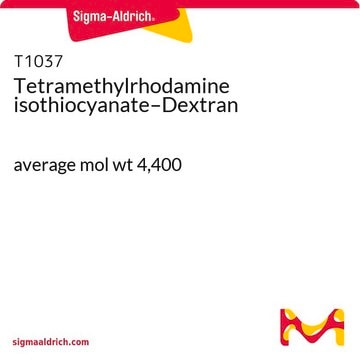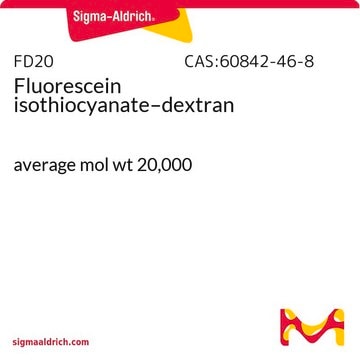FD40S
Fluorescein isothiocyanate–dextran
average mol wt 40,000
Synonim(y):
FITC–Dextran
About This Item
Polecane produkty
pochodzenie biologiczne
synthetic (organic)
białko sprzężone
FITC conjugate
Postać
powder
masa cząsteczkowa
average mol wt 40,000
zakres etykietowania
0.003-0.020 mol FITC per mol glucose
kolor
yellow to dark orange
rozpuszczalność
H2O: soluble 25 mg/mL, clear to slightly hazy, yellow to deep orange
temp. przechowywania
2-8°C
Szukasz podobnych produktów? Odwiedź Przewodnik dotyczący porównywania produktów
Opis ogólny
Zastosowanie
- Fluorescein-dextran microscopy.
- To evaluate the in vivo pulmonary vascular permeability in polymorphonuclear leukocyte α-defensins expressing transgenic mice.
- To quantify endocytic activity by flow cytometry.
- To label α-lactalbumin and ribonuclease.
Powiązanie
Uwaga dotycząca przygotowania
Inne uwagi
Hasło ostrzegawcze
Warning
Zwroty wskazujące rodzaj zagrożenia
Zwroty wskazujące środki ostrożności
Klasyfikacja zagrożeń
Eye Irrit. 2 - Skin Irrit. 2 - STOT SE 3
Organy docelowe
Respiratory system
Kod klasy składowania
11 - Combustible Solids
Klasa zagrożenia wodnego (WGK)
WGK 3
Temperatura zapłonu (°F)
Not applicable
Temperatura zapłonu (°C)
Not applicable
Środki ochrony indywidualnej
Eyeshields, Gloves, type N95 (US)
Certyfikaty analizy (CoA)
Poszukaj Certyfikaty analizy (CoA), wpisując numer partii/serii produktów. Numery serii i partii można znaleźć na etykiecie produktu po słowach „seria” lub „partia”.
Masz już ten produkt?
Dokumenty związane z niedawno zakupionymi produktami zostały zamieszczone w Bibliotece dokumentów.
Klienci oglądali również te produkty
Powiązane treści
Dekstran jest polimerem anhydroglukozy. Składa się w około 95% z wiązań alfa-D-(166). Pozostałe (163) wiązania odpowiadają za rozgałęzienie dekstranu.
Dextran is a polymer of anhydroglucose. It is composed of approximately 95% alpha-D-(166) linkages. The remaining (163) linkages account for the branching of dextran.
Nasz zespół naukowców ma doświadczenie we wszystkich obszarach badań, w tym w naukach przyrodniczych, materiałoznawstwie, syntezie chemicznej, chromatografii, analityce i wielu innych dziedzinach.
Skontaktuj się z zespołem ds. pomocy technicznej









